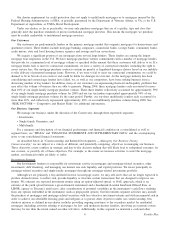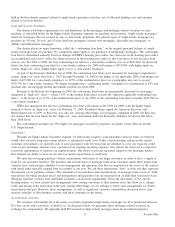Freddie Mac 2008 Annual Report Download - page 19
Download and view the complete annual report
Please find page 19 of the 2008 Freddie Mac annual report below. You can navigate through the pages in the report by either clicking on the pages listed below, or by using the keyword search tool below to find specific information within the annual report.increase from $1.0 billion as of September 8, 2008 to $45.6 billion. The amount remaining under the announced funding
commitment from Treasury will be $155.4 billion, which does not include the initial liquidation preference of $1 billion
reflecting the cost of the initial funding commitment (as no cash was received). The corresponding annual dividends payable
to Treasury will increase to $4.6 billion. This dividend obligation exceeds our annual historical earnings in most periods, and
will contribute to increasingly negative cash flows in future periods, if we pay the dividends in cash. In addition, the
continuing deterioration in the financial and housing markets and further GAAP net losses will make it more likely that we
will continue to have additional large draws under the Purchase Agreement in future periods, which will make it significantly
more difficult to pay senior preferred dividends in cash in the future. Additional draws would also diminish the amount of
Treasury’s remaining commitment available to us under the Purchase Agreement. As a result of additional draws and other
factors, our cash flow from operations and earnings will likely be negative for the foreseeable future, there is significant
uncertainty as to our future capital structure and long-term financial sustainability, and there are likely to be significant
changes to our capital structure and business model beyond the near-term that we expect to be decided by Congress and the
Executive Branch.
Impact of Conservatorship and Related Actions on Our Business
Our business objectives and strategies have in some cases been altered since we were placed into conservatorship, and
may continue to change. Based on our charter, public statements from Treasury and FHFA officials and guidance from our
Conservator, we have a variety of different, and potentially competing, objectives, including:
• providing liquidity, stability and affordability in the mortgage market;
• immediately providing additional assistance to the struggling housing and mortgage markets;
• reducing the need to draw funds from Treasury pursuant to the Purchase Agreement;
• returning to long-term profitability; and
• protecting the interests of the taxpayers.
These objectives create conflicts in strategic and day-to-day decision making that will likely lead to suboptimal
outcomes for one or more, or possibly all, of these objectives. We regularly receive direction from our Conservator on how
to pursue certain of these objectives. During the fourth quarter, the Conservator directed us to focus our efforts on assisting
homeowners in the housing and mortgage markets. We responded by offering large-scale loan modification programs,
temporarily suspending foreclosures and evictions and implementing other loss mitigation activities. These efforts are
intended to help homeowners and the mortgage market and may help to mitigate credit losses, but some of them are
expected to have an adverse impact on our future financial results. As a result, we will, in some cases, sacrifice the
objectives of reducing the need to draw funds from Treasury and returning to long-term profitability as we provide this
assistance. Additional draws on the Purchase Agreement will further increase our ongoing dividend obligations and,
therefore, extend the period of time until we might be able to return to profitability.
On February 18, 2009, the Obama Administration announced the HASP, which includes (a) an initiative that will allow
mortgages currently owned or guaranteed by us to be refinanced without obtaining additional credit enhancement beyond that
already in place for that loan; and (b) an initiative to encourage modifications of mortgages for both homeowners who are in
default and those who are at risk of imminent default, through various government incentives to servicers, mortgage holders
and homeowners. At present, it is difficult for us to predict the full extent of our activities under these initiatives and assess
their impact on us. However, to the extent that our servicers and borrowers participate in these programs in large numbers, it
is likely that the costs we incur associated with modifications of loans, the costs associated with the servicer and borrower
incentive fees and the potential accounting impacts will be substantial.
Given the important role the Obama Administration has placed on Freddie Mac in addressing housing and mortgage
market conditions, we may be required to take other actions that could have a negative impact on our business, financial
results or condition. There are also other actions being contemplated by Congress, such as legislation that would provide
bankruptcy judges the ability to lower the principal amount or interest rate, or both, on mortgage loans in bankruptcy
proceedings that we anticipate will increase our credit losses.
Because we expect many of these objectives and initiatives will result in significant costs, and the extent to which we
will be compensated or receive additional support for implementation of these actions is unclear, there is significant
uncertainty as to the ultimate impact these activities will have on our future capital or liquidity needs. However, we believe
that the increased level of support provided by Treasury and FHFA, as described above, is sufficient in the near-term to
ensure we have adequate capital and liquidity to continue to conduct our normal business activities. Management is in the
process of identifying and considering various actions that could be taken to reduce the significant uncertainties surrounding
the business, as well as the level of future draws under the Purchase Agreement; however, our ability to pursue such actions
may be limited based on market conditions and other factors. Any actions we take will likely require approval by FHFA and
Treasury before they are implemented. In addition, FHFA, Treasury or Congress may direct us to focus our efforts on
16 Freddie Mac
























